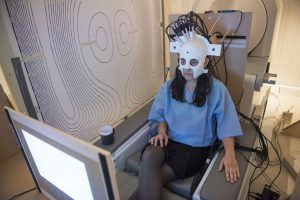
July 20, 2017, by Dr. Meghan Gray
Can you read my mind? New advances in brain imaging

Dr. Matt Brookes
The School of Physics and Astronomy has led the way in medical imaging, thanks to the scientific legacy of the late Sir Peter Mansfield. Sir Peter won the Nobel Prize in Medicine in 2004 for the development of Magnetic Resonance Imaging (MRI).
Recently, Dr. Matt Brookes and Prof Richard Bowtell from the Sir Peter Mansfield Imaging Centre were awarded a £1.6 million grant from the Wellcome Trust to transform brain imaging by combining superconductors, quantum mechanics…and 3D printing.
In this guest post, Dr. Brookes describes the exciting research now underway.
Imaging the brain
Our research group has begun work on a project to transform brain imaging. Magnetoencephalography, or MEG, is a technique to image brain activity, and works by measuring magnetic fields outside the head that are generated by the normal flow of electrical current through the brain. By mathematically modelling these fields, we can make images showing changes in current flow through the brain when subjects undertake a task.
Current MEG systems, which use superconducting sensors, are large and cumbersome. Systems weigh several tonnes; they are also “one-size-fits-all” which means they cannot be used for babies and children whose heads are too small. One of the biggest challenges with the current systems is that patients must keep still whilst they are scanned; even a ½ cm movement during a 20-minute scan can ruin the measurement.
From quantum mechanics to wearable brain imaging systems

The vision: Current MEG systems involve cryogenic sensors which make them big, bulky and cumbersome. We want to turn these systems into something which can be worn like a hat. PhD student Elena Boto demonstrates a prototype.
In collaboration with neuroscientists at University College London and funded by a £1.6 million grant from the Wellcome Trust, we are attempting to turn these superconducting systems into something that can be worn on the head like a hat. We aim to create a system that will allow patients to move whilst being scanned and will also allow everyone, from newborn babies to the elderly, to benefit from this technology.
At the heart of the new system is a new type of sensor, called an optically pumped magnetometer. This sensor relies on the quantum mechanical properties of rubidium atoms to detect the very small magnetic fields generated by the brain.
Important pilot work on these sensors was undertaken by Nottingham undergraduates Madeline Wyburd and Isabel Gale as part of their 3rd year research projects. As a first step, they used the sensors to measure magnetic fields from muscles in the arm. Now armed with our new research grant, we are attempting to use the same sensors — mounted on the head using advanced 3D printing — to measure human brain activity.
No comments yet, fill out a comment to be the first

Leave a Reply